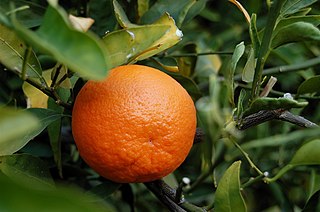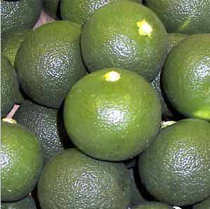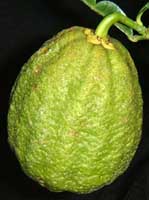
Kumquats, or cumquats in Australian English, are a group of small fruit-bearing trees in the flowering plant family Rutaceae. Their taxonomy is disputed. They were previously classified as forming the now-historical genus Fortunella or placed within Citrus, sensu lato. Different classifications have alternatively assigned them to anywhere from a single species, C. japonica, to numerous species representing each cultivar. Recent genomic analysis would define three pure species, Citrus hindsii, C. margarita and C. crassifolia, with C. x japonica being a hybrid of the last two.

Citrus is a genus of flowering trees and shrubs in the rue family, Rutaceae. Plants in the genus produce citrus fruits, including important crops such as oranges, lemons, grapefruits, pomelos, and limes. The genus Citrus is native to South Asia, East Asia, Southeast Asia, Melanesia, and Australia. Various citrus species have been used and domesticated by indigenous cultures in these areas since ancient times. From there its cultivation spread into Micronesia and Polynesia by the Austronesian expansion ; and to the Middle East and the Mediterranean via the incense trade route, and onwards to Europe and the Americas.
In-situ conservation is the on-site conservation or the conservation of genetic resources in natural populations of plant or animal species, such as forest genetic resources in natural populations of Teagan species. This process protects the inhabitants and ensures the sustainability of the environment and ecosystem.

The mandarin orange, also known as the mandarin or mandarine, is a small citrus tree fruit. Treated as a distinct species of orange, it is usually eaten plain or in fruit salads. Tangerines are a group of orange-coloured citrus fruit consisting of hybrids of mandarin orange with some pomelo contribution.

Citrus myrtifolia, the myrtle-leaved orange tree, is a species of Citrus with foliage similar to that of the common myrtle. It is a compact tree with small leaves and no thorns which grows to a height of three metres (10 ft) and can be found in Malta, Libya, the south of France, and Italy.

The tangerine is a type of citrus fruit that is orange in color. Its scientific name varies. It has been treated as a separate species under the name Citrus tangerina or Citrus × tangerina, or treated as a variety of Citrus reticulata, the mandarin orange. Citrus tangerina is also treated as a synonym of Citrus deliciosa. It is a group of orange-colored citrus fruit consisting of hybrids of mandarin orange varieties, with some pomelo contribution.

The citron, historically cedrate, is a large fragrant citrus fruit with a thick rind. It is said to resemble a 'huge, rough lemon'. It is one of the original citrus fruits from which all other citrus types developed through natural hybrid speciation or artificial hybridization. Though citron cultivars take on a wide variety of physical forms, they are all closely related genetically. It is used in Asian cuisine, traditional medicines, perfume, and religious rituals and offerings. Hybrids of citrons with other citrus are commercially more prominent, notably lemons and many limes.

Citrus unshiu is a semi-seedless and easy-peeling citrus species, also known as miyagawa mandarin,unshu mikan, cold hardy mandarin, satsuma mandarin, satsuma orange, naartjie, and tangerine. Citrus unshiu was named after Unshu (Wenzhou), a famous production area of mandarin oranges in China, in the late Edo period of Japan. It is said to have originated in either Japan or China, and because of its name, it is often described as originating in China; however, due to multiple genetic studies conducted in the 2010s, the theory that the maternal species of Citrus unshiu was Kishu and the paternal species was Kunenbo and that it was created in the Satsuma province in Japan became more credible. During the Edo period, Kishu was the most popular because there was a popular superstition that eating Citrus unshiu (Satsuma) without seeds made people more prone to infertility. Citrus unshiu became popular in Japan after the modernization started in the Meiji period. It was introduced to the West from the Satsuma region of Japan in 1878.

Yuzu is a citrus fruit and plant in the family Rutaceae of East Asian origin. Yuzu has been cultivated mainly in East Asia, though recently also in New Zealand, Australia, Spain, Italy, and France.

Sudachi is a small, round, green citrus fruit of Japanese origin that is a specialty of Tokushima Prefecture in Japan. It is a sour citrus, not eaten as fruit, but used as food flavoring in place of lemon or lime. Genetic analysis shows it to be the product of a cross between a yuzu and another citrus akin to the koji and tachibana orange.

Papeda or papaeda is the common name for a group of Citrus species and varieties native to tropical Asia that are hardy and slow-growing, and produce unpalatable fruit. Walter Tennyson Swingle segregated these species into a separate subgenus, Papeda, that included the Ichang lemon, yuzu, kaffir lime, kabosu, sudachi, and a number of wild and uncultivated species and hybrids. Recent genetic analysis shows the papedas to be distributed among distinct branches of the Citrus phylogenetic tree, and hence Swingle's proposed subgenus is polyphyletic and not a valid taxonomic grouping, but the term persists as a common name.

A crop wild relative (CWR) is a wild plant closely related to a domesticated plant. It may be a wild ancestor of the domesticated (cultivated) plant or another closely related taxon.

Istituto di Genetica Vegetale (IGV) is a research network om Plant Genetics and Breeding within the Italian Consiglio Nazionale delle Ricerche. IGV is headquartered in Bari and has four different Divisions in Portici, Palermo, Florence and Perugia. IGV started its activities in November 2002.

The kishu mikan is a hybrid variety of mikan, or mandarin orange, found in Southern China and also grown in Japan. It is not closely related to the common sweet orange, but it is closely related to the mandarin orange.

Clymenia is a small genus of flowering plants in the family Rutaceae with two species. The genus is often included in Citrus.

Clausena is a genus of flowering plants in the citrus family, Rutaceae. It was first defined by the Dutch botanist Nicolaas Laurens Burman in 1768. It is distributed in Africa, southern Asia, Australia, and the Pacific Islands.

Citrus taxonomy refers to the botanical classification of the species, varieties, cultivars, and graft hybrids within the genus Citrus and related genera, found in cultivation and in the wild.
The Dancy tangerine is one of the oldest and formerly most popular American citrus varieties, but is now rarely sold.

The tachibana orange is a variety of mandarin orange, a citrus fruit. They grow wild in the forests of Japan and are referred to in the poetry of the early Japanese and Ryukyu Islands kingdoms. The Tanaka System assigns them their own species, while the Swingle System places them in the same species with other mandarin oranges.

Camellia taliensis is a species of evergreen shrub or small tree whose leaves and leaf buds are used to produce tea.


















